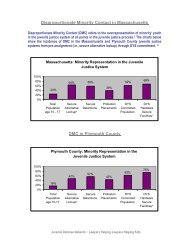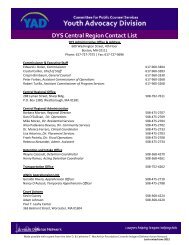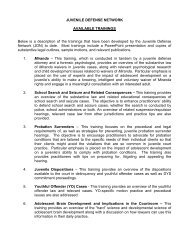States rethink 'adult time for adult crime' - the Youth Advocacy Division
States rethink 'adult time for adult crime' - the Youth Advocacy Division
States rethink 'adult time for adult crime' - the Youth Advocacy Division
You also want an ePaper? Increase the reach of your titles
YUMPU automatically turns print PDFs into web optimized ePapers that Google loves.
What Makes Teens Tick; A flood of hormones, sure. But also a host of struct...plain <strong>the</strong> behaviors that make adolescence so exciting--and so exasperating<br />
functions: <strong>the</strong> part of <strong>the</strong> brain that helps you know where <strong>the</strong> light switch is in your<br />
bathroom even if you can't see it in <strong>the</strong> middle of <strong>the</strong> night. The very last part of <strong>the</strong><br />
brain to be pruned and shaped to its <strong>adult</strong> dimensions is <strong>the</strong> prefrontal cortex, home<br />
of <strong>the</strong> so-called executive functions--planning, setting priorities, organizing thoughts,<br />
suppressing impulses, weighing <strong>the</strong> consequences of one's actions. In o<strong>the</strong>r words,<br />
<strong>the</strong> final part of <strong>the</strong> brain to grow up is <strong>the</strong> part capable of deciding, I'll finish my<br />
homework and take out <strong>the</strong> garbage, and <strong>the</strong>n I'll IM my friends about seeing a<br />
movie.<br />
"Scientists and <strong>the</strong> general public had attributed <strong>the</strong> bad decisions teens make to<br />
hormonal changes," says Elizabeth Sowell, a UCLA neuroscientist who has done<br />
seminal MRI work on <strong>the</strong> developing brain. "But once we started mapping where and<br />
when <strong>the</strong> brain changes were happening, we could say, Aha, <strong>the</strong> part of <strong>the</strong> brain<br />
that makes teenagers more responsible is not finished maturing yet."<br />
RAGING HORMONES<br />
Hormones, however, remain an important part of <strong>the</strong> teen-brain story. Right about<br />
<strong>the</strong> <strong>time</strong> <strong>the</strong> brain switches from proliferating to pruning, <strong>the</strong> body comes under <strong>the</strong><br />
hormonal assault of puberty. (Research suggests that <strong>the</strong> two events are not closely<br />
linked because brain development proceeds on schedule even when a child<br />
experiences early or late puberty.) For years, psychologists attributed <strong>the</strong> intense,<br />
combustible emotions and unpredictable behavior of teens to this biochemical<br />
onslaught. And new research adds fresh support. At puberty, <strong>the</strong> ovaries and testes<br />
begin to pour estrogen and testosterone into <strong>the</strong> bloodstream, spurring <strong>the</strong><br />
development of <strong>the</strong> reproductive system, causing hair to sprout in <strong>the</strong> armpits and<br />
groin, wreaking havoc with <strong>the</strong> skin, and shaping <strong>the</strong> body to its <strong>adult</strong> contours. At<br />
<strong>the</strong> same <strong>time</strong>, testosterone-like hormones released by <strong>the</strong> adrenal glands, located<br />
near <strong>the</strong> kidneys, begin to circulate. Recent discoveries show that <strong>the</strong>se adrenal sex<br />
hormones are extremely active in <strong>the</strong> brain, attaching to receptors everywhere and<br />
exerting a direct influence on serotonin and o<strong>the</strong>r neurochemicals that regulate<br />
mood and excitability.<br />
The sex hormones are especially active in <strong>the</strong> brain's emotional center--<strong>the</strong> limbic<br />
system. This creates a "tinderbox of emotions," says Dr. Ronald Dahl, a psychiatrist<br />
at <strong>the</strong> University of Pittsburgh. Not only do feelings reach a flash point more easily,<br />
but adolescents tend to seek out situations where <strong>the</strong>y can allow <strong>the</strong>ir emotions and<br />
passions to run wild. "Adolescents are actively looking <strong>for</strong> experiences to create<br />
intense feelings," says Dahl. "It's a very important hint that <strong>the</strong>re is some particular<br />
hormone-brain relationship contributing to <strong>the</strong> appetite <strong>for</strong> thrills, strong sensations<br />
and excitement." This thrill seeking may have evolved to promote exploration, an<br />
eagerness to leave <strong>the</strong> nest and seek one's own path and partner. But in a world<br />
where fast cars, illicit drugs, gangs and dangerous liaisons beckon, it also puts <strong>the</strong><br />
teenager at risk.<br />
That is especially so because <strong>the</strong> brain regions that put <strong>the</strong> brakes on risky,<br />
impulsive behavior are still under construction. "The parts of <strong>the</strong> brain responsible<br />
<strong>for</strong> things like sensation seeking are getting turned on in big ways around <strong>the</strong> <strong>time</strong> of<br />
puberty," says Temple University psychologist Laurence Steinberg. "But <strong>the</strong> parts <strong>for</strong><br />
exercising judgment are still maturing throughout <strong>the</strong> course of adolescence. So<br />
you've got this <strong>time</strong> gap between when things impel kids toward taking risks early in<br />
adolescence, and when things that allow people to think be<strong>for</strong>e <strong>the</strong>y act come online.<br />
It's like turning on <strong>the</strong> engine of a car without a skilled driver at <strong>the</strong> wheel."<br />
DUMB DECISIONS<br />
Increasingly, psychologists like Steinberg are trying to connect <strong>the</strong> familiar patterns<br />
of adolescents' wacky behavior to <strong>the</strong> new findings about <strong>the</strong>ir evolving brain<br />
structure. It's not always easy to do. "In all likelihood, <strong>the</strong> behavior is changing<br />
because <strong>the</strong> brain is changing," he says. "But that is still a bit of a leap." A critical<br />
tool in making that leap is functional magnetic resonance imaging (fMRI). While<br />
ordinary MRI reveals brain structure, fMRI actually shows brain activity while<br />
subjects are doing assigned tasks.<br />
file:///L|/JDN/Brain%20Resources/Brain%20Developmen...iling%20Packet/8.%20What%20Makes%20Teens%20Tick.htm (4 of 8)8/16/2006 4:44:18 PM
















